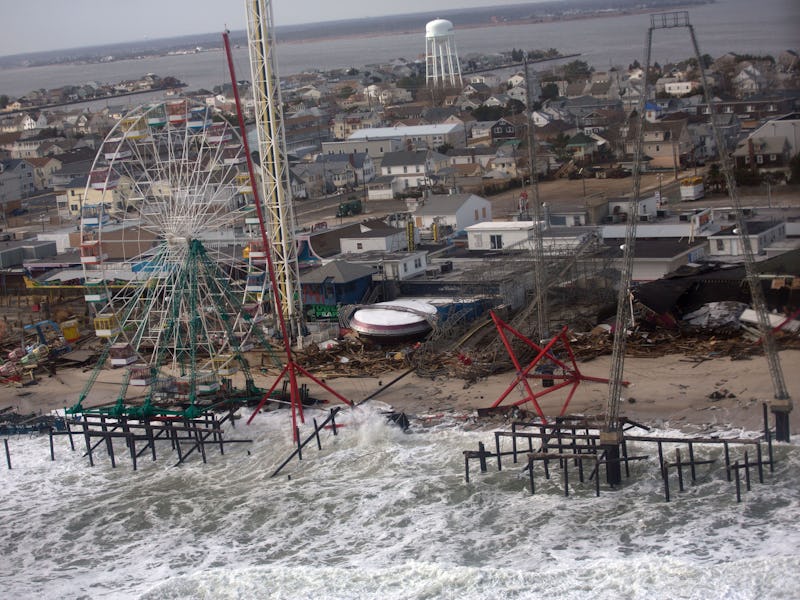Data scientists put a staggering price tag on climate change's effects
By the year 2090, the total amount could push into the hundreds of billions.

Hurricanes, floods, and other natural disasters can destroy and displace communities. Beyond the human cost, this damage is unimaginably expensive for many who are affected. New research out Monday puts a price tag on how bad things might get.
The most extreme natural disaster events are becoming much more expensive, say researchers, who published their work in the journal Proceedings of the National Academy of Sciences.
Among the top one percent of the damages caused by natural disasters (floods, extreme temperatures, droughts, storms, wildfires, and landslides) researchers noticed a dramatic increase in the financial cost over time.
Damages from the most severe incidents increased 20-fold between 1970 and 2010, from approximately $500 million to $10 billion.
Previous research has focused on average damages, which show a relatively weak increasing trend. The new research separates the most extreme events, ones with the largest damages, from the others.
They observed a “rightward skewing and tail fattening”
Statistics showing an increase in natural disaster cost skewed toward the more catastrophic events, the researchers found. They observed a “rightward skewing and tail fattening,” meaning there was more evidence of cost increase toward the right, or more severe, end of the spectrum. Fatter tail, bigger cost increase.
The most expensive damages were much more expensive than the less expensive ones, especially in temperate regions, as shown by this graph's fat right tail.
Growth of extreme damages has been the strongest in traditionally temperate areas, the study finds. For that top 1 percent of natural disasters, the cost of a single event increased by $18 million in tropical areas and by $46.5 million in temperate zones, Francesca Chiaromonte, Ph.D., professor of statistics at Penn State University and co-corresponding author, tells Inverse.
“This may seem counterintuitive, because we are used to thinking of temperate regions as less affected by natural disasters than, say, the tropics,” Chiaromonte says.
As climate change causes severe events to become more common in temperate areas, “our results suggest that our defaults in thinking of the impact of natural disasters may be obsolete,” Chiaromonte explains. In other words, communities in temperate regions may need to start implementing adaptation policies like those that exist in the tropics, where hurricanes are traditionally more frequent and damaging.
Climate change could cost the United States hundreds of billions of dollars per year by 2090.
In the United States, one such temperate area, researchers have produced startling estimates of the scope of the potential damages from climate change.
By the year 2090, the total amount could push into the hundreds of billions of dollars annually in the US alone, write Environmental Protection Agency researchers in a study published in April in the journal Nature Climate Change. (The authors note that the views presented are their own and not those of the EPA.)
The effects of climate change on agriculture, coastal flooding, and water resources are likely to drive those figures, the EPA scientists note. They report potential changes across 22 sectors of the US, including human health, infrastructure, electricity, and agriculture.
While there’s some variation among those domains, “there are no regions that escape some mix of adverse impacts,” the EPA scientists write. Lowering the potential damage would require lowering carbon emissions and, in some cases, figuring out ways to adapt to the inevitable effects of climate change.
The top 1 percent of natural disaster damages have increased dramatically, and the pattern is more pronounced in temperate areas.
Adaptation efforts in the tropics have had at least some effect in mitigating damage, the new study on economic damages finds. That’s one reason the more severe increase in damages occurs in temperate regions: In addition to the fact that the range of disasters is broadening, communities in temperate regions simply haven’t begun to properly adapt yet.
The new study’s authors didn’t set out to study the effects of climate change.
“But what we found is simple and stark: The cost of the worse events has increased by many folds over the last decades,” Chiaromonte says. “And it’s not just that people move and build in risky areas.”
The results set the stage for more analyses and point to a growing need for climate risk management, the authors write. Just as the EPA study found, that means lowering emissions as well as preparing for damages that we won’t be able to prevent.
“Albeit indirectly,” Chiaromonte says, “we are providing strong support for the notion that mitigation of climate change is critical also from an economic perspective.”
Abstract: Climate change has increased the frequency and intensity of natural disasters. Does this translate into increased economic damages? To date, empirical assessments of damage trends have been inconclusive. Our study demonstrates a temporal increase in extreme damages, after controlling for a number of factors. We analyze event-level data using quantile regressions to capture patterns in the damage distribution (not just its mean) and find strong evidence of progressive rightward skewing and tail-fattening over time. While the effect of time on averages is hard to detect, effects on extreme damages are large, statistically significant, and growing with increasing percentiles. Our results are consistent with an upwardly curved, convex damage function, which is commonly assumed in climate-economics models. They are also robust to different specifications of control variables and time range considered and indicate that the risk of extreme damages has increased more in temperate areas than in tropical ones. We use simulations to show that underreporting bias in the data does not weaken our inferences; in fact, it may make them overly conservative.